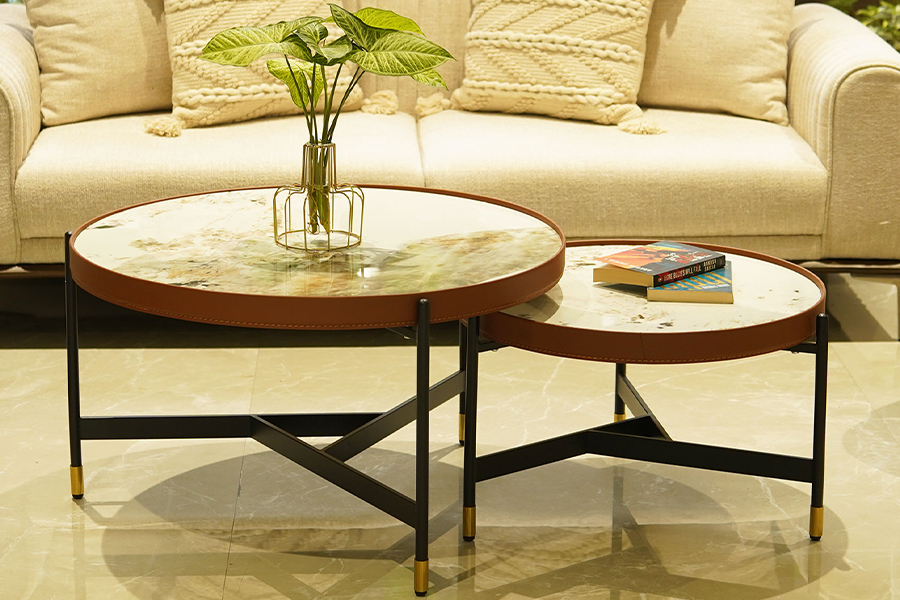Designer coffee tables are more than just functional surfaces—they are central design elements that anchor living spaces with character and style. As interior trends evolve, so do the materials used in crafting these statement pieces. Whether you’re looking for something timeless or bold, understanding current material trends can help you choose a coffee table that enhances your space and reflects your aesthetic.
1. Natural Stone: Marble, Travertine, and Onyx
Why It’s Trending
Natural stone is having a major moment in luxury furniture. Marble, with its distinct veining and refined elegance, remains a top choice for both modern and classic interiors. Travertine, with its warmer tones and matte texture, offers a more earthy and understated feel, while onyx adds a touch of drama with its translucent layers and bold coloring.
Best For
- Contemporary and minimalist spaces
- Statement-making centerpieces
- High-contrast designs when paired with metals or wood
2. Mixed Materials: Wood + Metal Combinations
Why It’s Trending
Designers are embracing the fusion of organic and industrial elements. Coffee tables that combine warm woods (like walnut or oak) with steel or brass bases bring balance and sophistication. The blend of textures adds visual interest and versatility, making these tables easy to integrate into various décor styles.
Best For
- Industrial-chic homes
- Transitional interiors
- Rooms that need a blend of warmth and edge
3. Reclaimed and Sustainable Wood
Why It’s Trending
With growing environmental awareness, more designers are turning to reclaimed or sustainably sourced wood. Each piece comes with unique grain patterns, imperfections, and history. This trend appeals to eco-conscious homeowners who value authenticity and responsible sourcing.
Best For
- Rustic and farmhouse settings
- Eco-friendly interiors
- Artisanal or handcrafted aesthetics
4. Smoked and Tinted Glass
Why It’s Trending
Glass coffee tables have always been valued for their ability to make a space feel open. Today, designers are elevating this material with smoked or colored glass. Tints like amber, bronze, and grey create a moody, upscale effect without overpowering the room.
Best For
- Small spaces needing visual lightness
- Modern and glam interiors
- Rooms with layered lighting and metallic accents
5. Terrazzo Revival
Why It’s Trending
Terrazzo has made a strong comeback in furniture design. Made from chips of marble, quartz, and other materials bound in concrete or resin, it offers vibrant texture and color. Its playful, speckled surface adds a creative touch to otherwise minimalist décor.
Best For
- Artistic or eclectic homes
- Mid-century modern influences
- Bright, casual living spaces
In many contemporary settings, the coffee table is no longer an afterthought—it’s the star. From sculptural bases to curated materials, today’s designer tables are about creating ambiance as much as providing surface area.
6. Metal Finishes: Matte Black, Brass, and Chrome
Why It’s Trending
Metal continues to dominate, especially in accent pieces. Matte black offers a sleek, grounded look. Brass brings warmth and vintage charm. Chrome, though more retro, is gaining renewed popularity in high-gloss, postmodern designs.
Best For
- Contemporary and Art Deco-inspired homes
- Pairing with glass or stone tops
- Geometric or bold bases
7. Leather and Upholstered Tops
Why It’s Trending
A soft-top coffee table adds warmth, texture, and a tactile element. Leather-wrapped or upholstered surfaces are particularly popular in lounge-style living rooms, often doubling as ottomans or casual seating.
Best For
- Multifunctional family rooms
- Cozy, layered design schemes
- Boho or eclectic spaces
Conclusion
From raw stone and warm woods to sleek metals and playful terrazzo, today’s designer coffee tables reflect a diverse blend of natural, artistic, and functional influences. Whether your taste leans toward minimalism or maximalism, the material of your table can define the tone of the entire room. When chosen thoughtfully, it becomes a lasting piece that enhances both form and function.

